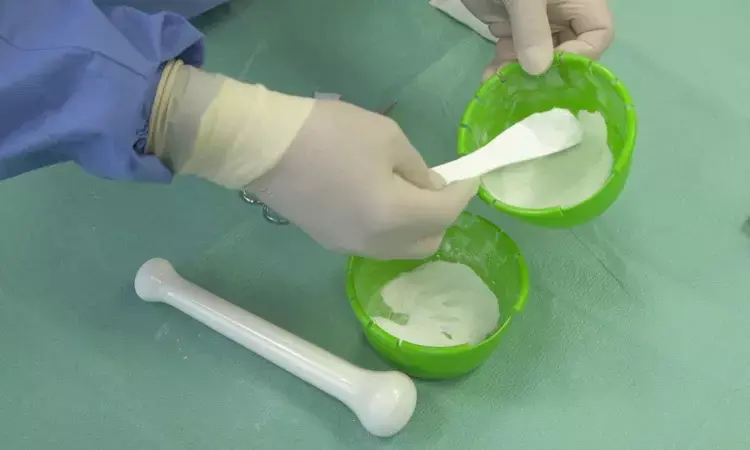- Home
- Medical news & Guidelines
- Anesthesiology
- Cardiology and CTVS
- Critical Care
- Dentistry
- Dermatology
- Diabetes and Endocrinology
- ENT
- Gastroenterology
- Medicine
- Nephrology
- Neurology
- Obstretics-Gynaecology
- Oncology
- Ophthalmology
- Orthopaedics
- Pediatrics-Neonatology
- Psychiatry
- Pulmonology
- Radiology
- Surgery
- Urology
- Laboratory Medicine
- Diet
- Nursing
- Paramedical
- Physiotherapy
- Health news
- Fact Check
- Bone Health Fact Check
- Brain Health Fact Check
- Cancer Related Fact Check
- Child Care Fact Check
- Dental and oral health fact check
- Diabetes and metabolic health fact check
- Diet and Nutrition Fact Check
- Eye and ENT Care Fact Check
- Fitness fact check
- Gut health fact check
- Heart health fact check
- Kidney health fact check
- Medical education fact check
- Men's health fact check
- Respiratory fact check
- Skin and hair care fact check
- Vaccine and Immunization fact check
- Women's health fact check
- AYUSH
- State News
- Andaman and Nicobar Islands
- Andhra Pradesh
- Arunachal Pradesh
- Assam
- Bihar
- Chandigarh
- Chattisgarh
- Dadra and Nagar Haveli
- Daman and Diu
- Delhi
- Goa
- Gujarat
- Haryana
- Himachal Pradesh
- Jammu & Kashmir
- Jharkhand
- Karnataka
- Kerala
- Ladakh
- Lakshadweep
- Madhya Pradesh
- Maharashtra
- Manipur
- Meghalaya
- Mizoram
- Nagaland
- Odisha
- Puducherry
- Punjab
- Rajasthan
- Sikkim
- Tamil Nadu
- Telangana
- Tripura
- Uttar Pradesh
- Uttrakhand
- West Bengal
- Medical Education
- Industry
Spiked tibial cement spacer provides superior stability than conventional design in 2stage Revision TKA

Articulating cement spacers are frequently used in staged approaches for infected total knee arthroplasty (TKA). Kwang Hwan Jung et al conducted a study to investigate whether a tibial cement spacer (TCS) with spikes could reduce spacer-related problems in two-stage revision TKA (R-TKA).The article has been published in "International Orthopaedics" journal.
A total of 27 patients (27 knees; 10 men and 17 women) who underwent two-stage R-TKA for infected TKA were retrospectively analyzed. Group A comprised 12 patients who used TCS with spikes added to the bottom surface, whereas group B consisted of 15 patients who used conventional TCS with a flat bottom (FCS). For each group, plain radiographs were obtained after cement spacer implantation and before R-TKA to measure mediolateral (ML) translation and TCS's tilting angle. Patients' demographic data, ML translation of the TCS, and changes in the TCS's tilting angle between the groups were analyzed.
Spacer design
The authors chose commercial bone cement (Simplex® HV with gentamicin; Stryker, Kalamazoo, MI, USA) that was based on poly (methyl methacrylate), had a powder-to-liquid ratio of 2:1, and had an antibiotic-to-bone cement ratio of 1:50 per package. If a specific culture organism was known preoperatively, directed antibiotic choices were made; if the organism was unknown, the formula for antibiotics was based on 1 g of meropenem and 1 g of vancomycin per package. Additional antibiotics were mixed with bone cement containing 0.8 g of gentamycin sulfate. All cement spacers were molded intra-operatively using knee cement spacer molds, which allowed for FCS and TCS sizes ranging from 66 to 76 mm and 62 to 68 mm, respectively. Adequate thickness of the TCS was determined under traction of the leg at full extension and flexion of the knee joint at 90° to achieve gap balancing. Immediately prior to cement hardening, several spikes were made using a surgical probe on the bottom surface of the TCS. In the control group with a flat bottom, the cement was naturally hardened and used without performing the aforementioned technique.
The results of the study were:
• The mean patient age was 74.5 (range, 63–85) years in group A and 73.5 (range, 60–81) years in group B (p=0.96).
• No significant difference in the thickness of the polyethylene inserted in the previous primary TKA was identified
• There were no statistically significant differences in WBC count, ESR, and CRP level between the two groups
• The mean ML translation was significantly lower in group A than that in group B (1.7 mm vs. 5.4 mm, p=0.04).
• The mean change in the tilting angle was significantly lower in group A than that in group B (4.5° vs. 19.4°, p=0.047).
The authors concluded that - The spiked TCS in two-stage R-TKA is easy to fabricate and provides superior stability compared to the TCS with a conventional design.
Further reading:
Does spiked tibial cement spacer reduce spacer related problems in two stage revision total knee arthroplasty for infection? Kwang Hwan Jung, Chae Chil Lee et al, International Orthopaedics (2022) 46:2009–2017 https://doi.org/10.1007/s00264-022-05438-6
MBBS, Dip. Ortho, DNB ortho, MNAMS
Dr Supreeth D R (MBBS, Dip. Ortho, DNB ortho, MNAMS) is a practicing orthopedician with interest in medical research and publishing articles. He completed MBBS from mysore medical college, dip ortho from Trivandrum medical college and sec. DNB from Manipal Hospital, Bengaluru. He has expirence of 7years in the field of orthopedics. He has presented scientific papers & posters in various state, national and international conferences. His interest in writing articles lead the way to join medical dialogues. He can be contacted at editorial@medicaldialogues.in.
Dr Kamal Kant Kohli-MBBS, DTCD- a chest specialist with more than 30 years of practice and a flair for writing clinical articles, Dr Kamal Kant Kohli joined Medical Dialogues as a Chief Editor of Medical News. Besides writing articles, as an editor, he proofreads and verifies all the medical content published on Medical Dialogues including those coming from journals, studies,medical conferences,guidelines etc. Email: drkohli@medicaldialogues.in. Contact no. 011-43720751


